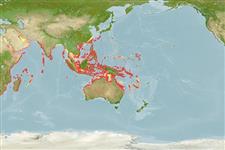Environment: milieu / climate zone / depth range / distribution range
Ecologia
marinhas associadas(os) a recifes; intervalo de profundidade 1 - 40 m (Ref. 9710). Tropical; 30°N - 30°S
Indo-West Pacific: Red Sea and East Africa to Papua New Guinea, north to Miyakejima, Japan (Ref. 559), south to Australia and New Caledonia (Ref. 2142).
Tamanho / Peso / Idade
Maturity: Lm ? range ? - ? cm
Max length : 14.5 cm TL macho/indeterminado; (Ref. 11441)
Descrição breve
Chaves de identificação | Morfologia | Morfometria
Espinhos dorsais (total) : 8; Raios dorsais moles (total) : 9; Espinhos anais: 2; Raios anais moles: 8; Vértebras: 14. Distinguished by having the following characteristics: Dorsal-fin rays VII-I, 9; anal-fin rays II,8; pectoral-fin rays 14; pelvic-fin rays I,5; pored lateral line scales 25; predorsal scales 5; circumpeduncular scales 12; total gill rakers 24, developed gill rakers, 21; without oblique dark bars on cheek (Ref. 93839). Color in life coppery with iridescence, paler posteriorly; a blackish stripe, bordered by a blue line, running from front of snout through eye and beyond; a narrow blue streak on maxilla. Large and oblique mouth; median predorsal scales 5; preopercular ridge smooth with posterior and most of ventral margin serrate. Black bar encircling caudal peduncle present in both young and adult phases (Ref. 02142).
Inhabits holes in rocks or under ledges in shallow waters. Known to occur in mixed aggregates with Apogon apogonoides during summer and autumn, but form separate aggregates in winter and spring (Ref. 559 and 637). Forms aggregations (Ref 90102).
Life cycle and mating behavior
Maturities | Reprodução | Spawnings | Egg(s) | Fecundities | Larvas
Mouthbrooders (Ref. 240). Distinct pairing during courtship and spawning (Ref. 205).
Randall, J.E., T.H. Fraser and E.A. Lachner, 1990. On the validity of the Indo-Pacific cardinalfishes Apogon aureus (Lacepède) and A. fleurieu (Lacepède), with description of a related new species from the Red Sea. Proc. Biol. Soc. Wash. 103(1):39-62. (Ref. 2142)
Categoria na Lista Vermelha da IUCN (Ref. 130435)
Ameaça para o homem
Harmless
Utilização humana
Pescarias: pouco comercial; Aquário: Espécies comerciais
Ferramentas
Relatórios especiais
Descarregue XML
Fontes da internet
Estimates based on models
Preferred temperature (Ref.
123201): 24.7 - 29, mean 27.5 °C (based on 804 cells).
Phylogenetic diversity index (Ref.
82804): PD
50 = 0.5000 [Uniqueness, from 0.5 = low to 2.0 = high].
Bayesian length-weight: a=0.01148 (0.00705 - 0.01869), b=3.16 (3.03 - 3.29), in cm total length, based on LWR estimates for this species & Genus-body shape (Ref.
93245).
Nível Trófico (Ref.
69278): 3.6 ±0.54 se; based on food items.
Resiliência (Ref.
120179): Elevada, tempo mínimo de duplicação da população menor que 15 meses (Preliminary K or Fecundity.).
Fishing Vulnerability (Ref.
59153): Low vulnerability (10 of 100).
Nutrients (Ref.
124155): Calcium = 105 [54, 166] mg/100g; Iron = 0.815 [0.484, 1.351] mg/100g; Protein = 18.7 [17.5, 19.8] %; Omega3 = 0.127 [0.076, 0.203] g/100g; Selenium = 31.4 [17.4, 58.6] μg/100g; VitaminA = 59.1 [17.6, 192.7] μg/100g; Zinc = 1.42 [0.95, 2.04] mg/100g (wet weight);
